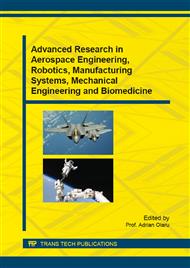[1]
Europejskie Ankietowe Badanie Zdrowia. (European Health Survey Respondents – in polish), (2009), GUS.
Google Scholar
[2]
E. Mikołajewska, Egzoszkielety we współczesnych środowiskach zintegrowanych, (Exoskeletons in today's integrated environments – in polish). Zeszyty naukowe WSOWL, vol. 4 (2011) 246-253.
Google Scholar
[3]
E. Mikołajewska, Zastosowania automatyki i robotyki w wózkach dla niepełnosprawnych i egzoszkieletach medycznych, (Automation and robotics applications in wheelchairs for the disabled and exoskeletons – in polish). Zeszyty Naukowe WSOWL, vol. 5 (2011).
DOI: 10.2478/rehab-2013-0002
Google Scholar
[4]
E. Mikołajewska, Niepełnosprawność - zagadnienia, problemy, rozwiązania, (Disability - issues, problems and solutions – in polish). Państwowy Fundusz Rehabilitacji Osób Niepełnosprawnych, vol. 4 (2012) 121-141.
Google Scholar
[5]
H. Lee, W. Kim, J. Han and C. Han, The technical trend of the exoskeleton robot system for human power assistance, International Journal of Precision Engineering and Manufacturing, vol. 13 (2012) 1491-1497.
DOI: 10.1007/s12541-012-0197-x
Google Scholar
[6]
P. Ciężkowski, Analiza porównawcza systemów transportu typu – egzoszkielet, (Comparative analysis of the type of transport systems – exoskeleton). Zeszyty Naukowe Instytutu Pojazdów, vol. 95/4 (2013) 31-39.
Google Scholar
[7]
Y. L. Hu, D. Liu and J. F. Liu, Analysis and Research on the Mechanics of Human Body Exoskeleton Movement, Applied Mechanics and Materials, vol. 687-691 (2014) 191-194.
DOI: 10.4028/www.scientific.net/amm.687-691.191
Google Scholar
[8]
Y. Zhang, Q. Liu, J.L. Jiang, L. Y. Zhang and R. R. Shen, Configuration design and simulation of exoskeleton for upper limb rehabilitation train, Applied Mechanics and Materials, Trans Tech Publishing, Switzerland, vol. 701-702 (2014) 654.
DOI: 10.4028/www.scientific.net/amm.701-702.654
Google Scholar
[9]
Y. Sahin, F. M. Botsalı, M. Kalyoncu, M. Tinkir, Ü. Önen, N. Yılmaz, Ö. K. Baykan and A. Çakan, Force feedback control of lower extremity exoskeleton assisting of load carrying human, Applied Mechanics and Materials, Trans Tech Publishing, Switzerland, vol. 598 (2014).
DOI: 10.4028/www.scientific.net/amm.598.546
Google Scholar
[10]
Y. Sahin, F. M. Botsalı, M. Kalyoncu, M. Tinkir, Ü. Önen, N. Yılmaz and A. Çakan, Mechanical design of lower extremity exoskeleton assisting walking of load carrying human, Applied Mechanics and Materials, Trans Tech Publishing, Switzerland, vol. 598 (2014).
DOI: 10.4028/www.scientific.net/amm.598.141
Google Scholar
[11]
J.L. Pons, Upper-limb robotic rehabilitation exoskeleton: tremor suppression, Rehabilitation Robotics. Retrieved 15. 12. 2014 http: /www. intechopen. com/ books/rehabilitation_robotics/ upperlimb_ robotic_rehabilitation_exoskeleton_tremor_suppression.
DOI: 10.5772/5175
Google Scholar
[12]
Robaid. Retrieved 06. 26. 2015, http: /www. robaid. com/bionics/cyberdyne-hal-5-exoskeleton-robot. htm.
Google Scholar
[13]
H. Kawamoto, Pilot study of locomotion improvement using hybrid assistive limb in chronic stroke patients BMC Neurology (2013). Retrieved 01. 05. 2015, from http: /www. biomedcentral. com / 1471-2377/13/131.
DOI: 10.1186/1471-2377-13-141
Google Scholar
[14]
V. Krasin, V. Gandhi, Z. Yang and M. Karamanoglu, EMG based elbow joint powered exoskeleton for biceps brachii strength augmentation http: /www. ijcnn. org/assets/docs/frontmatter-v18. pdf.
DOI: 10.1109/ijcnn.2015.7280643
Google Scholar
[15]
Toyama, S. Retrieved 04. 22. 2015, from Toyama Research: http: /www. tuat. ac. jp /~toyama/ research_assistancesuitE. htm.
Google Scholar
[16]
D. Chakarov, I. Veneva, M. Tsveov and T. Tiankov, New exoskeleton arm concept design and actuation for haptic interaction with virtual objects. Journal of Theoretical and Applied Mechanics. vol. 44/4 (2014) 3–14.
DOI: 10.2478/jtam-2014-0019
Google Scholar
[17]
T. Mikolajczyk, K. Bednarczyk and A. Mikolajczyk, Model of human hand controlled using pneumatic muscles, Applied Mechanics and Materials, Trans Tech Publishing, Switzerland, vol. 555 (2014) 155-162.
DOI: 10.4028/www.scientific.net/amm.555.155
Google Scholar
[18]
Step2CNC. Retrieved 05. 01. 2015, www. akcesoria. cnc. info. pl/step2cnc. htm.
Google Scholar
[19]
T. Mikolajczyk, A. Borboni, D. Mackowski and M. Matuszewski, Example of tool with two numerical controlled axes, Applied Mechanics and Materials, Trans Tech Publishing, Switzerland, vol. 772 (2015) 224-229.
DOI: 10.4028/www.scientific.net/amm.772.224
Google Scholar
[20]
T. Mikolajczyk, D. Dorsz and L. Romanowski, Design and control system of parallel kinematics manipulator, Applied Mechanics and Materials, Trans Tech Publishing, Switzerland, vol. 436 (2013) 390-39.
DOI: 10.4028/www.scientific.net/amm.436.390
Google Scholar
[21]
A. Olaru, S. Olaru and N. Mihai, Proper smart method of the inverse kinematics problem, Applied Mechanics and Materials, Trans Tech Publishing, Switzerland, vol. 772 (2015) 455-460.
DOI: 10.4028/www.scientific.net/amm.772.455
Google Scholar
[22]
A. Olaru, S. Olaru and N. Mihai, Proper assisted research method solving of the robots inverse kinematic problem, Applied Mechanics and Materials, Trans Tech Publishing, Switzerland, vol. 555 (2014) 135-146.
DOI: 10.4028/www.scientific.net/amm.555.135
Google Scholar
[23]
A. Olaru, S. Olaru and N. Mihai, Modeling and simulation of the multiple robot's applications, Applied Mechanics and Materials, Trans Tech Publishing, Switzerland, vol. 656 (2014) 223-232.
DOI: 10.4028/www.scientific.net/amm.656.223
Google Scholar


